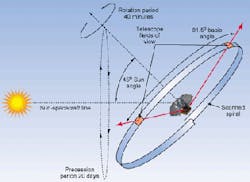The US Naval Observatory (USNO; Washington, DC), with funding from NASA Goddard Space Flight Center (Greenbelt, MD), has begun assembling the pieces of the Full-sky Astrometric Mapping Explorer (FAME) satellite, scheduled for launch in October 2004. The FAME optical space telescope will obtain the most precise data yet for over 40 million stars down to 15th magnitude, including positions, distances, motions, brightness, and colors.
The FAME telescope will measure stellar positions down to 500 microarc seconds. "The positional accuracy of the observations, such as proper motion and parallax, will be 20 times better than has ever been done before," said Kenneth Johnston, scientific director of USNO and FAME principal investigator.
The FAME program has introduced some new technologies to satisfy NASA's space mission goals of "faster, cheaper, better." The satellite, which won the coveted NASA stamp of approval over 29 other proposals, will use solar radiation pressure on its solar panels to smoothly precess the rotation axis for uniform imaging over many days, rather than using thruster burns (see figure).
An array of 24 charge-coupled devices (CCDs) will be used for precise imaging. While the use of such a large number of CCDs has never been accomplished in space, the USNO has experience with the use of large arrays for ground-based applications. In addition, smaller arrays have been used in space on the Hubble Space Telescope. Scientific Imaging Technology (Portland, OR) has been chosen to provide the array.
Sharing the wealth of information
The five-year mission is 85% funded by NASA, said Johnston, for research gains such as absolute luminosity calibrations of standard candle stars, a map of galactic dark matter, and exploring the transition between brown dwarfs and giant planets. The other 15% is provided by the USNO, to gain precise, "almost-inertial" maps.
Other collaborators on the project include Lockheed Martin Advanced Technology Center (Palo Alto, CA), which will fabricate the instrumentation, and the Naval Research Lab (Washington, DC), which will provide the spacecraft bus and systems integration. The Smithsonian Astrophysical Observatory (Cambridge, MA) will perform synthesis and verification of the scientific measurement system.
The telescope technology used on FAME is similar to the successful Hipparcos satellite launched by the European Space Agency (ESA) in the late 1980s. A single optical telescope will observe two fields of view simultaneously. Both fields are imaged onto a single focal plane of the 24 CCDs in TD1 mode, synchronized with the 40-minute rotation period of the spacecraft.
The data from FAME will greatly expand upon the observations by Hipparcos. The Hipparcos catalog currently contains the most accurate positions of 100,000 stars. Also in the works for astrometric mapping is the ESA's GAIA mission, which proposes to map a billion stars after launch in 2012.

